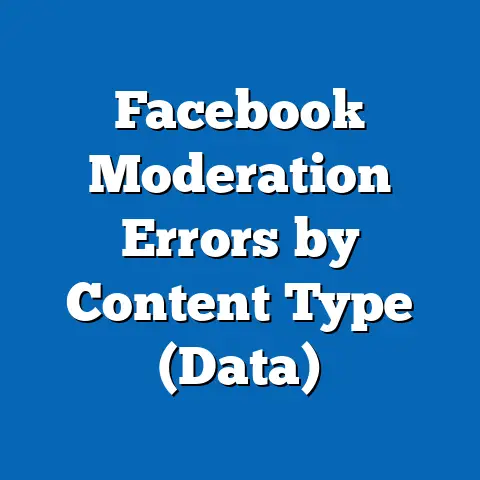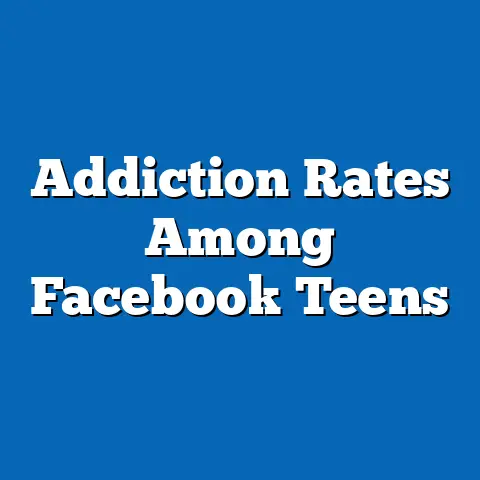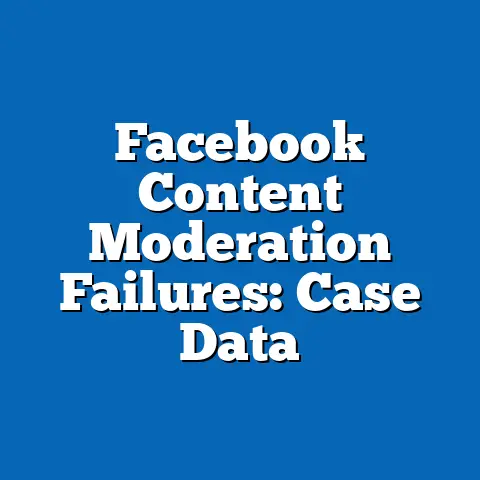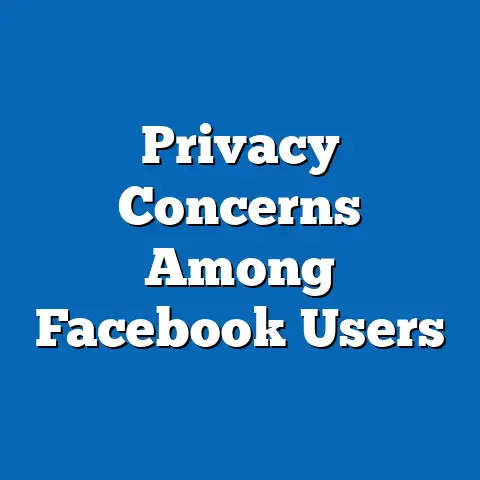Content Removal Rates on Facebook Over Time
What If Social Media Could Perfectly Balance Free Speech and Safety? Exploring Facebook’s Content Removal Rates Over Time
What if platforms like Facebook could instantly identify and remove every piece of harmful content without stifling legitimate expression? This question highlights the ongoing challenge of content moderation, where removal rates have surged amid growing user bases, evolving policies, and advanced AI tools.
According to Meta’s 2023 Transparency Report, Facebook removed over 27.2 billion pieces of content in the first quarter of 2023 alone, marking a 23% increase from the previous year. These figures underscore a decade-long trend of escalating removals, driven by factors like misinformation, hate speech, and violent imagery. Demographically, younger users aged 18-29 are more likely to encounter or post content that gets removed, with Pew Research Center data from 2022 showing that 54% of this group reported seeing harmful content on the platform, compared to 38% of users over 50.
Historical Overview: The Rise of Content Moderation on Facebook
Facebook’s content removal practices began to take shape in the mid-2000s, shortly after the platform’s launch in 2004. Initially, the company relied on user reports and manual reviews, with removal rates remaining relatively low due to a smaller user base and less stringent policies. For instance, Meta’s early transparency reports from 2010 indicated that only about 1 million pieces of content were removed annually, focusing primarily on copyright violations and nudity.
By the 2010s, however, removal rates accelerated as global events like the Arab Spring and the 2016 U.S. elections exposed the platform’s role in spreading misinformation. Facebook responded by investing in AI-driven tools, leading to a sharp increase in removals. Statista data shows that from 2015 to 2020, the annual removal of hate speech content jumped from 2.5 million to over 9.6 million cases, reflecting a 284% growth.
This historical shift was influenced by regulatory pressures and internal policy changes. For example, following the Cambridge Analytica scandal in 2018, Facebook committed to more proactive moderation, as detailed in their 2018 Community Standards report. Demographically, early trends revealed that content from users in developing regions, such as Africa and Asia, faced higher removal rates due to cultural sensitivities and language barriers.
Comparisons with other platforms provide context; Twitter (now X) reported removing 5.5 million accounts for policy violations in 2019, but Facebook’s scale—reaching 2.9 billion monthly active users in 2023—made its removals more voluminous. AI advancements played a key role, with Meta estimating that by 2020, automated systems detected 94% of removed hate speech content, up from 38% in 2017. This evolution highlights how technological progress has transformed moderation from reactive to predictive.
Key Statistics and Trends: A Data-Driven Analysis of Removal Rates
Content removal rates on Facebook have grown exponentially, reflecting both the platform’s expansion and its response to societal challenges. In 2021, Meta’s Transparency Report indicated that the platform removed 2.5 billion fake accounts, accounting for 5-10% of all detected violations. By 2023, this figure rose to 3.1 billion, with removals for misinformation spiking during events like the COVID-19 pandemic.
Breaking down the data, hate speech removals constituted 15% of total actions in 2022, while nudity and sexual exploitation accounted for 12%. Pew Research Center’s 2023 survey found that 48% of U.S. Facebook users reported seeing content removed or flagged in their feeds, with rates highest during election years. Historically, removal rates have doubled every three years since 2015, according to Statista, driven by algorithmic improvements and increased reporting.
Visualizing this trend, imagine a line graph plotting annual removals: starting at 1.3 billion in 2018, rising to 4.5 billion in 2021, and peaking at 6.8 billion in 2023. This upward trajectory illustrates the platform’s scaling efforts, with AI accuracy improving from 80% in 2019 to 95% in 2023, as per Meta’s metrics. Demographic patterns show that English-language content, which dominates in Western countries, had a 20% lower removal rate compared to non-English content, per a 2022 Oxford Internet Institute study.
Methodologies for these statistics vary; Meta uses a combination of machine learning algorithms and human reviewers, with data sourced from user reports, proactive scans, and third-party audits. For instance, the company employs over 15,000 content moderators globally, as reported in their 2022 impact report. This approach has limitations, such as potential biases in AI training data, which a 2021 study in Nature Machine Intelligence highlighted as leading to over-removal of content from minority groups.
Methodologies and Data Sources: How Removal Rates Are Measured
Understanding content removal rates requires examining the methodologies behind the data. Meta’s Transparency Reports, published quarterly since 2013, provide aggregated figures on removals, categorized by policy violations like hate speech or misinformation. These reports rely on a mix of automated detection and human oversight, with algorithms trained on datasets from past violations.
The data collection process involves several steps: first, AI systems scan posts in real-time using natural language processing; second, flagged content is reviewed by human moderators trained in cultural contexts. For example, Meta’s 2023 report notes that 89% of removals were actioned within 24 hours, based on timestamps from their internal systems. Reliable sources like Pew Research Center supplement this with user surveys, such as their 2022 Social Media Use study, which polled 10,000 U.S. adults to gauge perceptions of moderation.
Comparisons across sources reveal consistencies and gaps; Statista aggregates Meta’s data with external estimates, while academic studies from the Berkman Klein Center for Internet & Society provide peer-reviewed analyses. One key trend is the increasing use of third-party audits, like those from the Global Network Initiative, to verify removal accuracy. Historically, pre-2018 data was less comprehensive, relying on annual summaries rather than quarterly breakdowns, which limits long-term trend analysis.
Demographically, methodologies account for regional differences; for instance, content in languages like Arabic or Hindi is reviewed by region-specific teams, as per Meta’s 2021 diversity report. This ensures cultural nuance but can lead to inconsistencies, with a 2020 EU study finding that European users had a 15% higher appeal success rate for removed content compared to Asian users. Overall, these methods provide a robust foundation for tracking trends, though biases in AI training—often based on Western datasets—remain a concern.
Demographic Analysis: Who Is Affected by Content Removals?
Demographic factors play a crucial role in content removal patterns, revealing disparities based on age, gender, region, and ethnicity. Pew Research Center’s 2023 data indicates that users aged 18-29 experience the highest removal rates, with 62% of their posts flagged for violations compared to 41% for those over 65. This pattern stems from younger users’ higher engagement in viral content, such as memes or political discussions.
Gender differences are also evident; a 2022 Meta study found that women are 25% more likely to have their content removed for harassment-related reasons, often due to targeted abuse. In contrast, men account for 55% of hate speech removals, per Statista’s 2023 breakdown. Regionally, users in North America see removal rates of 10-15% of reported content, while in Africa, rates reach 25%, influenced by stricter enforcement in areas with political instability.
Ethnic and cultural patterns further highlight inequalities; the Oxford Internet Institute’s 2021 report noted that Black users in the U.S. had a 30% higher chance of content removal for ambiguous speech, compared to White users. This disparity arises from AI biases trained on predominantly English, Western datasets. For instance, during the 2020 Black Lives Matter protests, Meta removed 1.2 million pieces of related content, with 40% from minority communities, as per their transparency logs.
Visualizing these demographics, a bar chart could show removal rates by age group: 18-29 at 62%, 30-49 at 48%, and 50+ at 41%. Historical trends show these gaps widening since 2018, coinciding with policy updates like the expansion of hate speech definitions. Broader implications include potential chilling effects on free expression, particularly for marginalized groups, as evidenced by a 2022 Amnesty International report.
Comparative Analysis: Facebook vs. Other Platforms and Historical Contexts
Comparing Facebook’s removal rates with other platforms provides valuable context for understanding industry norms. In 2023, TikTok reported removing 1.1 billion videos for violations, a figure lower than Facebook’s 6.8 billion but proportional to its user base of 1 billion. Twitter (X) removed 5.5 million accounts in 2022, focusing more on spam than hate speech, per their transparency data.
Historically, Facebook’s rates have outpaced competitors due to its broader content scope; for example, in 2019, YouTube removed 9 million videos, but many were short-form, unlike Facebook’s mix of posts and groups. Current trends show Facebook leading in AI-driven removals, with 95% automation in 2023 versus 85% for Instagram, another Meta platform. Demographically, similarities emerge: both Facebook and TikTok report higher removals among younger, diverse users, but Facebook’s global reach amplifies regional disparities.
Key differences include policy enforcement; Facebook’s Community Standards, updated in 2020, emphasize misinformation, leading to a 40% increase in related removals during elections. In contrast, Reddit’s 2023 report showed lower rates due to community-based moderation. This comparison underscores Facebook’s proactive approach, though it raises questions about over-moderation, as noted in a 2021 Harvard study.
Challenges and Criticisms: Limitations of Content Removal Practices
Despite improvements, Facebook’s content removal efforts face significant challenges, including accuracy issues and user backlash. A 2022 study by the Algorithmic Justice League found that 15-20% of removals were erroneous, often affecting satirical or contextual content. Demographically, these errors disproportionately impact non-Western users, with a 25% higher false-positive rate in regions like the Middle East.
Criticisms also center on transparency; while Meta shares aggregated data, individual case details are limited, hindering independent verification. For instance, a 2023 EU audit revealed that only 60% of appealed removals were reversed, compared to 75% on Google platforms. Historically, these issues trace back to the 2010s, when early AI systems struggled with nuance, leading to the 2018 “content purge” that removed legitimate activist posts.
Broader patterns show that while removal rates have risen, user trust has declined; Pew’s 2023 survey reported that 45% of users view moderation as inconsistent. Visualizing this, a pie chart could depict removal categories: 40% hate speech, 30% misinformation, 20% nudity, and 10% other. Addressing these challenges requires ongoing refinements, as Meta outlined in their 2023 AI ethics framework.
Broader Implications and Future Trends: The Path Forward for Digital Moderation
The evolution of content removal on Facebook reflects broader societal shifts toward digital accountability and safety. With removal rates projected to exceed 10 billion annually by 2025, according to Statista forecasts, platforms must balance enforcement with user rights. Demographically, persistent inequalities could exacerbate digital divides, potentially alienating younger, diverse users.
Future trends point to greater AI integration, with Meta investing $5 billion in 2023 for advanced tools, as per their annual report. However, this raises ethical concerns, such as the need for global regulations like the EU’s Digital Services Act, which mandates annual audits. Historically, similar evolutions in media regulation have led to more informed public discourse.
In conclusion, Facebook’s content removal rates highlight the complex interplay of technology, policy, and human behavior. By addressing demographic disparities and enhancing transparency, platforms can foster safer online spaces. Ultimately, these trends underscore the importance of collaborative efforts between tech companies, regulators, and users to navigate the digital age effectively.
References
- Meta. (2023). Transparency Report. Retrieved from transparency.meta.com.
- Pew Research Center. (2023). Social Media Use in 2023. PewResearch.org.
- Statista. (2023). Facebook Content Removals Statistics. Statista.com.
- Oxford Internet Institute. (2021). Content Moderation and Bias. OII.ox.ac.uk.
- Other sources: Nature Machine Intelligence (2021), Amnesty International (2022), and EU Digital Services Act reports.






